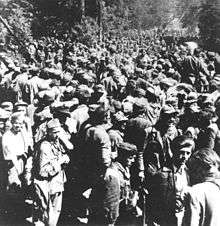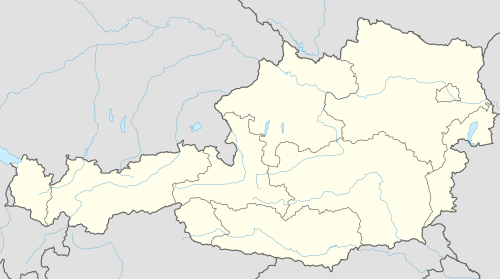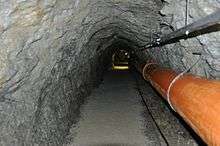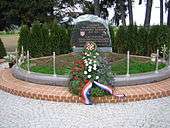Bleiburg repatriations
| Part of a series on |
| Aftermath of World War II in Yugoslavia |
|---|
| Main events |
| Massacres |
| Camps |
The Bleiburg repatriations (see terminology) occurred in May 1945, at the end of World War II in Europe, when tens of thousands of soldiers and civilians associated with the Axis fleeing Yugoslavia were repatriated to that country. They were subjected to forced marches together with captured columns in Yugoslavia. Tens of thousands were executed and many taken to forced labor camps. The events are named for the Carinthian border town of Bleiburg, where the initial repatriation was conducted.
On 3 May 1945, the government of the Independent State of Croatia (NDH), a fascist puppet state established in parts of occupied Yugoslavia, decided to flee to Austria and have the remnants of the Croatian Armed Forces (HOS) move there as soon as possible in order to surrender to the British Army. The Axis-aligned Slovene leadership issued a retreat order for the Slovene Home Guard on the same day. These forces, accompanied by civilians, joined the German Army Group E and other Axis units in withdrawal, including the XV SS Cossack Cavalry Corps and the Montenegrin National Army, that refused to surrender to the Red Army or the Yugoslav Partisans.
In the week after the German Instrument of Surrender, which marked the formal end of World War II in Europe, Axis forces in Yugoslavia repeatedly refused to surrender and battled the Partisans to avoid encirclement and keep escape routes open. The Slovene-led columns fought their way to the Austrian border near Klagenfurt on 14 May. Their surrender was accepted by the British and were interned in the nearby Viktring camp. When one of the columns of fleeing HOS troops intermingled with civilians approached the town of Bleiburg on 15 May, the British refused to accept their surrender and directed them to surrender to the Partisans, which the HOS leadership did after short negotiations. Other Axis prisoners in British captivity were repatriated to Yugoslavia in the following weeks. The repatriations were canceled by the British on 31 May, following reports of massacres.
The Yugoslav authorities moved the prisoners on forced marches throughout the country to internment and labor camps. Mass executions were carried out, the largest of which were in Tezno, Kočevski Rog and Huda jama. The aftermath of the repatriations was a taboo topic in Yugoslavia and the public and official commemoration of the victims would only begin several decades after the events. The number of casualties that occurred at the time of the repatriations and in the weeks that followed has proven difficult to ascertain, with exact numbers being a subject of much debate.
Terminology
Commonly used terms such as Bleiburg massacre, Bleiburg tragedy, Bleiburg crime, Bleiburg case, and also simply Bleiburg are used in Croatia in reference to the events in question.[1][2][3]
The term Way of the Cross (Croatian: Križni put) is a common subjective term, used mostly by Croatians, regarding the events after the repatriation itself.[1] The latter have been described as "death marches".[4][5]
Background
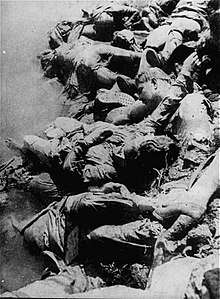
When World War II broke out in 1939, the government of the Kingdom of Yugoslavia declared its neutrality,[6] but most of its neighbours joined the Tripartite Pact by the beginning of 1941.[7] Yugoslavia came under heavy pressure to join the Axis and the Yugoslav government signed the Pact on 25 March 1941. However, demonstrations broke out in Belgrade against the decision and on 27 March, the government was overthrown in a coup d'état. The new Yugoslav government refused to ratify the signing of the Tripartite Pact, though it did not rule it out. Adolf Hitler reacted by launching the invasion of Yugoslavia on 6 April 1941, together with Italy and Hungary.[8]
On 10 April, German troops entered Zagreb and on the same day, the establishment of the Independent State of Croatia (Croatian: Nezavisna Država Hrvatska, NDH) was declared, an Axis puppet state led by the Ustaše. Ante Pavelić was named the Poglavnik ("leader") of NDH.[9] Yugoslavia capitulated to the Axis powers on 17 April.[10]
The rump Serbian territory was placed under German military administration, with the help of a civil puppet government led by Milan Nedić.[11] Slovene lands were divided between Germany, Italy and Hungary.[12]
Following the occupation and division of Yugoslavia, antisemitic laws were introduced in accordance to the Nazi Final Solution plan.[13] The Ustaše also enacted racial laws and systematically persecuted Serbs, as well as Jewish and Roma populations throughout the country. A concentration camp system was established, the largest of which was Jasenovac.[14] A series of massacres led to armed revolts of Serbs against the NDH. Wehrmacht General Edmund Glaise-Horstenau blamed the Ustaše crimes for the uprisings and criticized the government of NDH.[15]
In the wake of the invasion, remnants of the Royal Yugoslav Army organized the Serbian monarchist Chetniks as the first resistance movement. The Chetniks were led by Draža Mihailović and were recognized by the Yugoslav government-in-exile.[16] The Communist Party of Yugoslavia refrained from open conflict with the Axis forces while the Molotov–Ribbentrop Pact between Germany and the Soviet Union was in effect. Following the start of Operation Barbarossa, the Communist-led Yugoslav Partisans issued their call for an uprising.[17]
Josip Broz Tito was the supreme commander of the Partisan forces. The Chetniks and the Partisans, the two main guerrilla resistance units, initially cooperated against the Axis, but their cooperation soon fell apart and they turned against each other. The Chetniks started to collaborate with the Axis and Allied support shifted to the Partisan side.[18][19]
End of the war
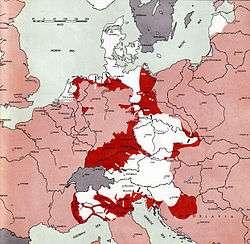
The arrival of Soviet ground troops in the Belgrade Offensive and Allied logistical support enabled the Partisans to increase their offensive actions. By the end of 1944, with the help of the Red Army, they established control in Serbia, Macedonia, Montenegro and Dalmatia.[20] German forces retreated from Serbia, together with Nedić's forces.[21] The Wehrmacht and the HOS established a front in Syrmia to secure the retreat of the German Army Group E from the Balkans.[22] Mass killings of POWs and ethnic Germans followed after the Partisans secured control of Serbia.[23]
In May 1944, Tito founded an intelligence service known as the Department for People's Protection (OZNA), modeled after the Soviet NKVD. It represented a military intelligence service and a political secret police of the Communist Party.[24] In August 1944, he founded an army unit called People's Defence Force of Yugoslavia (Korpus narodne odbrane Jugoslavije, KNOJ), whose explicit assignment was to "liquidate Chetnik, Ustaša, White Guard and other anti-people gangs".[25]
In August 1944, a coup d'état against Ante Pavelić, known as the Lorković–Vokić plot, failed and its conspirators were arrested or executed. The main plotters wanted to align NDH with the Allies.[26] As the war progressed and it became clearer that the Axis would lose the war, the desertion rate in the NDH armed force grew, especially among the Croatian Home Guard.[27] The Chetniks also showed similar signs of desertion.[19] In contrast, the Ustaše Militia rarely disintegrated or defected to the Partisans.[28]
On 30 August 1944, Josip Broz Tito offered amnesty to Croatian Home Guards, Slovene Home Guards and Chetniks if they chose to defect to the Partisan side by 15 September. After 15 September, all who had not defected were to be brought to "people's courts". Similar calls were repeated several times after the deadline. In some cases, Croatian Home Guards were killed despite defecting to the Partisans.[29]
The Armed Forces of the Independent State of Croatia (HOS) were reorganized in November 1944 to combine the units of the Ustaše and Croatian Home Guard.[30] Throughout the war, the treatment of prisoners from the Croatian Home Guard, was relatively benign – Partisans would merely ridicule the captured domobran soldiers and then send them home if they didn't want to join the uprising. However, on 13 January 1945, Pavelić ordered the domobrani to merge with the Ustaša military, creating a force estimated at 280,000.[31]
By 1945, the Yugoslav Partisans were known as the Yugoslav People's Army, numbering more than 800,000 men organized into five field armies, and were in pursuit of the remnant of the defeated German and NDH forces.[32][33]
In March 1945, the 4th Yugoslav Army advanced through Lika, Croatian Littoral and Kvarner Gulf. Most of Bosnia and Herzegovina was in Partisan hands by the end of April. On 12 April, the Syrmian Front was broken and the 1st and 3rd Army advanced west through Slavonia. Only the northwestern part of NDH with Zagreb as its center remained under control of NDH authorities.[34] There were a large number of refugees in that area from other parts of NDH. The Partisans carried out reprisals against captured soldiers of the HOS, as well as civilian political opponents.[35]
Axis retreat
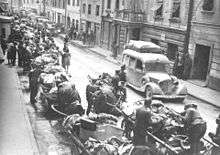
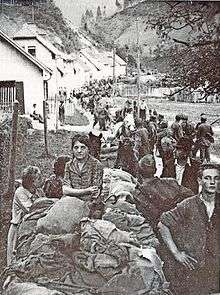
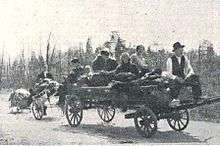
The collapse of the Syrmian front in April 1945 accelerated the withdrawal of German forces, that were in retreat from the Balkans since October 1944.[22] Like other Axis troops, forces of the NDH did not want to surrender to the Red Army or the Yugoslav Partisans and began retreating through Slovenia towards the Yugoslav-Austrian border, in order to surrender to the British forces advancing north from Italy.[36] A large-scale exodus of people was planned and organized by the authorities of the NDH despite the fact there was no strategic benefit to it: there simply was no viable destination for all the population to move to.[37] On 3 May, the Slovene leadership also decided to retreat to Austria.[38]
Some in the NDH and Slovene political and military leadership believed that the Western Allies will use them as anti-Communist forces and thus enable them to return to Yugoslavia and restore power with their support. Slovenian Bishop Gregorij Rožman made an appeal to the Allies to occupy Slovenia and prevent the Communists from taking power.[36] The NDH leadership abolished racial laws and on 6 May sent a request for collaboration with the Allies,[39] but all of these efforts failed.[36] While the NDH leadership may have organized a civilian retreat to bolster their claims that the Yugoslav Communists were after innocent civilian victims, the sheer number of civilians slowed down the retreat, made surrender to the Allies unfeasible, and ultimately led to the belief that they were nothing more than a human shield to the Ustaše.[37] However, the majority of the civilian refugees consisted of those holding anti-Communist views or who feared reprisals.[40]
Divisions of three Yugoslav armies were pursuing Axis forces.[22] Some units of the Yugoslav 4th Army managed to reach Carinthia before or at the same time as the retreating columns. Additional divisions of the 3rd and 4th Army were sent to the area in order to capture southern Carinthia and stop the retreating columns. The 1st and the 2nd Army were halted near Celje, while the 3rd Army advanced further in pursuit of the retreating columns.[41]
On 6 May 1945, the collaborationist government of the NDH fled Zagreb, and arrived to a location near Klagenfurt, Austria on 7 May.[42] Pavelić and the military leadership left Zaprešić on the evening of 7 May, intending to join the rest of his regime in Austria.[43] The bulk of the NDH leadership, including Pavelić, escaped in early May, fleeing to Western Europe and Latin America; Partisans were therefore only able to capture a small number of senior military NDH officers.[44]
Zagreb was defended by parts of the 1st Division of the Army of NDH and the 41st and 181st German Divisions, deployed along the unfinished fortified "Zvonimir line" between Sveti Ivan Žabno and Ivanić-Grad. The fierce battle with the Yugoslav 1st Army lasted from 5-8 May. The 7 May was the single bloodiest day in the 1,240-day long history of the 1st Proletarian Brigade, with 158 killed and 358 wounded in the fighting for Vrbovec.[45]
Besides the HOS, the Slovene Home Guard and the German Army Group E, there were also other military formations that were retreating.[46] The remnants of the Serbian State Guard, two regiments of the Serbian Volunteer Corps and a group of Chetniks surrendered to the British near the Italian-Yugoslav border on 5 May. These units were not repatriated to Yugoslavia.[47] The Montenegrin National Army, formed in April 1945 by Sekula Drljević with the support of the NDH government, to gather Montenegrins from NDH in the unit, were retreating together with Croatian forces.[48] Thousands of Russian Cossacks of the XVth SS Cossack Cavalry Corps, stationed in Yugoslavia since 1943, were also retreating to Austria.[49]
Tolstoy quotes a General Alexander telegram, sent to the Combined Chiefs of Staff, noting "50,000 Cossacks including 11,000 women, children and old men".[50] Shortly after midnight on 13 May 1945 the British V Corps Headquarters in Austria estimated that there were "approximately 30,000 POWs, surrendered personnel, and refugees in the Corps area. A further 60,000 reported moving north to Austria from Yugoslavia".[51]
On 7 May 1945, Germany surrendered unconditionally to the Allied powers, marking the practical end of World War II in Europe.[52] The German Instrument of Surrender applied to German Wehrmacht forces in Yugoslavia as well as those armed forces under German command such as the Croatian Armed Forces. This would ordinarily have meant that they too had to cease their activities on 8 May and stay where they found themselves. The Ustaše military, however, came under the command of Pavelić,[53] because as they were about to surrender, General Alexander Löhr, Commander-in-Chief of Army Group E handed command of the Croatian forces to Pavelić on 8 May.[44] Pavelić issued an order from Rogaška Slatina for his troops not to surrender to the Partisans, but to escape to Austria, to implement the Croatian government's decision of 3 May to flee to Austria.[44] Following the capitulation of Germany on 8 May, Tito issued an address via Radio Belgrade on 9 May calling upon all armed collaborators to surrender, threatening "merciless response" from the people and the army should they refuse to do so.[54]
On 8 May, Zagreb was liberated by the Partisan 1st and 2nd Army, with relatively few skirmishes and casualties in the city itself: the 1st Army reported to the General Staff that 10,901 enemy soldiers had been killed and 15,892 captured in taking Zagreb.[49] That same day, the headquarters of the 51st Vojvodina Division of the Yugoslav 3rd Army issued a dispatch ordering its units to consider all enemy officers and soldiers who continue resistance after midnight that day, and who are not part of units who had an organized surrender, as persons who do not have the status of prisoners of war, and to treat them as bandits. The German surrender obstructed the progress of the columns fleeing Croatia northward. By 9 May, Partisan forces had moved into Maribor which eliminated that escape route. They also took control of Celje on 10 May, but with a force insufficient to halt the columns that were escaping towards Dravograd.[54]
Escape route to Klagenfurt-Viktring
The Slovene Home Guard and Slovene civilians primarily used the route across the Loibl Pass.[36] Around 30,000 soldiers, including 10,000 to 12,000 Slovene Home Guards, 10,000 Germans, 4,000 Serbs, 4,000 members of the Russian Corps, and 6,000 Slovene civilians, were withdrawing to Austria.[55] The road to Loibl (Ljubelj) was congested with loaded cars, trucks, wagons and horse carts. Battles with the Partisans also slowed down the retreat.[41]
After passing the Loibl Pass, the columns were headed to the Drava Bridge at Hollenburg. The British were located north of the bridge. The bridge was guarded by German soldiers and was attacked by the Partisans on 7 May. Partisan reinforcements arrived on the following day and they set a barrier between Ferlach and Hollenburg, while units of the 4th Motorized Division and the 26th Division of the 4th Army were approaching Ferlach from the west. The Axis troops and civilians were surrounded and tried to fight their way through the blockades, but some German troops surrendered to the Partisans in the Rosental Valley.[56]
On 10 May, the main breakthrough attempt took place. The assault was carried out by the Slovene Home Guard, led by Vuk Rupnik, and the 7th SS Division "Prinz Eugen" and SS police units.[57] A radio contact was established with the British who were ready to accept them if they managed to cross the Drava. The British did not attack the Axis units fighting the Partisans. The Home Guard and SS troops launched an infantry attack on the town of Ferlach and took control of it on the evening. The remaining Partisan units in the vicinity were repelled on 11 May and the column of troops and refugees began crossing the Drava River. They were taken by the British to the Viktring camp near Klagenfurt. By 14 May, all units of the Slovene Home Guard surrendered to the British.[58]
Escape route to Bleiburg
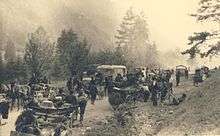
Croat troops and civilians mostly used escape routes towards Mežica and Bleiburg, and across the Kamnik Alps towards the Juan Valley in Austria.[36] The main Croatian column moved through the towns of Zidani Most, Celje, Štošanj, and Slovenj Gradec. On 11 May, the vanguard of the column reached Dravograd. However, the bridges across the Drava River were barricaded by Bulgarian units that reached the area on 9 May.[59] On 11–12 May, generals Vjekoslav Servatzy and Vladimir Metikoš entered discussions with Bulgarian generals to allow the Croatian column to pass into Austria.[60] The discussions were inconclusive, but the Bulgarians suggested they head in the direction of Prevalje and Bleiburg, which the column did.[61] Bleiburg was located some four kilometres northwest of the border of Austria and Yugoslavia. Parts of the columns that had weak or no protection were attacked by the Partisans - on 12 May, Politika carried Yugoslav Army reports of 15,700 prisoners of war in Maribor, Zidani Most, Bled, Jesenice and elsewhere. On 13 May, they reported over 40,000 prisoners taken near Rogaška Slatina, Celje, Velenje, Šoštanj, Dravograd, and elsewhere.[62]
The main column was encircled in the Dravograd pocket. The Croatian Armed Forces had artillery positions in a five kilometers linear distance from Dravograd to the south and used howitzers to fire on positions of the Yugoslav Army. On the night of 13 May, the elite HOS infantry units, commanded by General Rafael Boban, managed to break through the Partisan blockade and the column moved west through Ravne na Koroškem and Poljana towards Bleiburg.[63][64] A large number of Croat soldiers and civilians reached the field at Bleiburg on 14 May.[65] The 38th (Irish) Infantry Brigade headquarters were set up in Bleiburg,[66] having occupied the town on 12 May,[65] while the rest of the V Corps was stationed in Klagenfurt.[66] By 14 May, the British accepted thousands of retreating troops and civilians.[67]
Surrender at Bleiburg
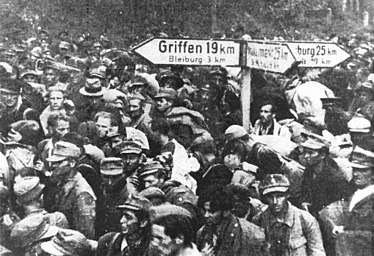
The main group of HOS troops and Croat civilians reached the Bleiburg field on 15 May. They were the head of the 45-65 kilometres long columns, numbering around 25,000 to 30,000 people.[68][46] The group included various branches of the NDH army, including the Air Force, Croatian Home Guard and Ustaše Militia, and civilian refugees. Most of them camped near the local railroad embankment. The Montenegrin National Army was placed east of the embankment.[69] Around 175,000 people were still on Yugoslav territory and moving towards Bleiburg.[68] Negotiations between representatives of the HOS, the Yugoslav Army and the British were held on the same day in the Bleiburg Castle.[70] The British negotiator was Brigadier Thomas Scott of the 38th (Irish) Infantry Brigade.[71] Ustaša infantry general Ivo Herenčić of the V Ustaša Corps, and a translator, Colonel Danijel Crljen, were involved in the surrender negotiations.[72][73]
In the afternoon of the same day, the Croatian forces started raising white flags in surrender.[74] The Partisan representatives included Major-General Milan Basta, the political commissar of the 51st Vojvodina Division, and Lieutenant Colonel Ivan Kovačič Efenka of the 14th Attack Division.[61][72] NDH military representatives attempted to negotiate a surrender to the British, but were directed to surrender to the Yugoslav military.[72] The Independent State of Croatia had joined the Geneva Convention on 20 January 1943, and was recognised by it as a "belligerent".[75]
The Partisan forces of the 51st Vojvodina Brigade of the Yugoslav 3rd Army and the 14th Slovenian Division had established tactical control over the field of Bleiburg.[66] Milan Basta set an ultimatum to the NDH negotiators - unconditional surrender within one hour, or else they would attack them and not uphold the norms of the international conventions of the Red Cross.[72][76] Basta's ultimatum was extended for another fifteen minutes, after which point a general surrender started.[72]
The exact events after the expiry of the ultimatum are the source of the original controversy regarding the repatriations. Teodor Pavić, described as a NDH "courier", wrote that the Partisan forces began strafing the crowd in the Bleiburg field with machine guns and shooting them individually.[76] Petar Brajović, a Yugoslav officer, described a fifteen- to twenty-minute machine gun and mortar fire on the column.[77] Strle wrote that the 3rd Battalion of the 11th "Zidanšek" Brigade and the 3rd Battalion of the 1st "Tomšič" Brigade were involved in the fire, and their records noted at least 16 deaths, mainly from the machine gun fire.[77] A Croatian soldier who survived, Zvonimir Zorić, wrote of a massacre at Bleiburg.[77]
_Das_Massaker_auf_dem_Bleiburger_Feld_durch_die_Staatsgrenze_zwischen_%C3%96sterreich_und_Jugoslawien_(Slowenien)_getrennt.jpg)
The notion of a massacre at the Bleiburg field was promoted by the remnants of the Ustaša in exile.[78] Croatian-American historian Jozo Tomasevich notes that it would have been physically impossible to assemble all the Croatian refugees in Bleiburg itself, so German and Croatian troops who are said to have surrendered "in Bleiburg" must have done so in various localities, including Bleiburg, and certainly not all in Bleiburg itself. He considers it impossible to establish the exact number of troops and civilians who tried to flee to Austria and were forced to surrender to the Partisans, and stresses that the number of victims has been inflated by pro-Ustaša sources for propaganda purposes, while communist sources have been diminishing it for similar reasons.[79] Croatian historian Martina Grahek Ravančić[80] wrote that the complete extent of the casualties sustained by the NDH column at Bleiburg on the day of the surrender was not described in any available sources. She described a short Yugoslav Army attack on the column as a certainty, likewise that there were casualties, but the number is unknown.[81]
Strle and Milan Basta claimed that as Ustaša forces tried to make a breakthrough at the north side of the valley, three British tanks were engaged to stop them, reportedly resulting in numerous casualties as well. However, only three Croatians provided testimony which supported the notion that there were British tanks in the proximity of the column, but with no mention of such a grave incident.[77] These kinds of unconfirmed reports of British military involvement, coupled with the actually legitimate acts of repatriation, were subsequently exaggerated by Ustaša supporters, particularly in the Croatian diaspora, in biased published works to accuse the British of war crimes.[78]
Later the same day, NDH generals Slavko Štancer, Vjekoslav Servatzy and Vladimir Metikoš oversaw the surrender to the Partisans.[81] British army reports say Štancer had previously been captured by the Partisans when they strayed from the column, seeking the British.[72] The surrender continued for several days and at various locations; it took until 21 May for Tito to order the Partisans to withdraw from Carinthia.[82]
Other Carinthian repatriations
Several other incidents and repatriations happened at and after this time elsewhere in Carinthia. Yugoslav intelligence officer Simo Dubajić negotiated with the British forces about the organization of surrender and repatriation elsewhere along the Yugoslav-Austrian border.[83] The extradition of Croat internees of the Viktring and Krumpendorf prisoner-of-war camps, located north of the Drava River, began on 18 May. The prisoners were assured that they were being transported to Italy. The repatriation took place in the village of Rosenbach and the town of Eberndorf. The transports continued on 19 May when Rosenbach and Lavamünd, northeast of Bleiburg, were used as extradition places, while some were transported to Bleiburg. Internees of the Grafenstein camp were also transported. Thousands more were handed over in the following days, mostly in Rosenbach and the Bleiburg railway station. The last transport was on 23 May when 800 Croat prisoners from Grafenstein were taken by rail to Bleiburg. British war diary records note that the extraditions of Croats ended on 24 May.[84]
The transports of Serbs and Montenegrins followed on 24 May, with three regiments of the Serbian Volunteer Corps. The first repatriation of larger groups of Slovene prisoners took place on 27 May, together with the remaining Serbs and Montenegrins. The repatriation of Slovenes also took place in Rosenbach or Bleiburg, except for the severely wounded that were accommodated in a hospital in Klagenfurt.[85] The Slovenes were also told by the British that they will be transported to camps in Italy.[68] The last Slovene group was handed over on 31 May. The following day, 2,700 Slovene civilians were scheduled to be transported to the border, but the transport was stopped by the British due to reports of massacres in Yugoslavia. All repatriations were canceled and a decision was made that only those who wanted to return to Yugoslavia would be transported.[86] According to an estimate of the British 5th Corps, a total of 26,339 people were extradited from the camps by 30 May, including 12,196 Croats, 8,263 Slovenes, 5,480 Serbs, and 400 Montenegrins.[85][87]
On the evening of 20 May, a group of NDH troops appeared near Ferlach, located approximately 40 km (25 mi) west of Bleiburg, and attempted to set terms for their passage west. "As the Ustaše did not want to surrender" reads the operational diary of the 2nd Battalion of the Partisan 11th Dalmatian Assault Brigade, "we attacked them at 21:00hrs. On this occasion we took 24 Ustaše soldiers and one officer".[88] British forces repatriated around 40,000 Cossacks to the Soviet Union's SMERSH, near Graz.[89] The repatriation of Cossacks to the Soviet Union from camps near Lienz began on 28 May.[90]
The march back
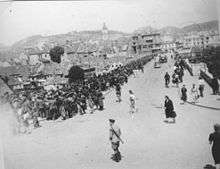

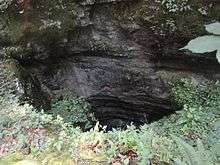
Representatives of the HOS of NDH accepted the surrender on 15 May at 16:00 hours. After the immediate repatriation of the soldiers at Bleiburg was complete, the Yugoslav forces began disarming them and started preparations for transporting the prisoners back.[91] A large number of columns of prisoners were formed in rows of four that were sent on a forced march through Slovenia. Due to the presence of the British Army, the initial treatment of prisoners was correct.[92] However, it got worse as the columns moved away from the border. The prisoners were given no food or water and were looted of valuables. Those who lagged behind were shot.[93] Individual killings and executions of smaller groups of men soon began. The columns were in Dravograd directed to Maribor or Slovenj Gradec and Celje.[94] On 17 May, the British started the repatriation of Croat internees of the Viktring camp, mostly members of the HOS.[95]
The columns marching towards Maribor, where transit camps were set, were moving along the Drava River.[93] During the march, bodies could be seen floating in the Drava and on the banks of the river.[96] The first prisoners arrived in Maribor on 17 May and were placed in transit camps. Other larger columns arrived in the following two days. At the camps, prisoners were sorted based on their unit and year of enlistment.[97] A part of the prisoners were sent on further marches or transported with trains to Celje and Zagreb. The rest were brought by trucks to anti-tank trenches in Tezno near Maribor, with their hands tied with wire, where they were lined up and killed. The killings lasted for several days until the trenches were filled with dead bodies.[93] It is estimated that around 15,000 people were killed in the Tezno massacre, mostly members of the HOS.[98]
Prisoners directed from Bleiburg to the town of Slovenj Gradec were joined by a large number of refugees that were stuck on the Dravograd-Slovenj Gradec road. Several transit camps were set in the town where prisoners were placed and sorted. Around 1,500 were killed in the nearby village of Žančani. The prisoners were only briefly held in Slovenj Gradec, mostly a day, before they continued their way to Celje. Anyone who stepped out of the column to take a rest or drink water was shot. Those that were too exhausted to continue the march were also shot. In Celje, most of the prisoners were placed in a football yard on the outskirts of the city. The command of the 11th Krajina Division of the 1st Army reported on 17 May that they received 30,000 prisoners. Anti-tank trenches near the Sava River and in the area of Bukovžlak were used for executions.[99] Prisoners were killed in various ways; on one occasion around 100-200 were locked in an enclosed water reservoir. Water was then slowly released until all of them drowned.[100][101]
A column of 40,000 people, consisting primarily of Croat soldiers, moved from Celje to Zidani Most on 18 May. A part of the captives were separated there, and led to the nearby forests and killed.[102] The column reached Samobor on 20 May.[103] They were not given food during the trip, but locals left them food and water by the road. Prisoners were placed in several smaller camps and prisons in the town, where selections were made again. Most of the prisoners were from Samobor sent to Zagreb and led through the city by foot. Trains with prisoners from other locations, mostly from Maribor, were also coming to Zagreb. The city's transit camps were not suitable for the accommodation of a large number of people, so many prisoners were placed in yards. The camps were surrounded with wire fences, behind which citizens gathered, bringing food or seeking relatives and friends.[104] One of the largest camps in the area was in Prečko. Prisoners were given food there, albeit not regularly. Around 50 died of hunger and illness.[105] Aleksandar Ranković, the chief of the intelligence service, was dissatisfied with the pace of executions in Zagreb and sent a letter to the Croatian branch of the OZNA, demanding greater resoluteness.[106] An increased number of arrests of Zagreb's citizens followed during June and July 1945.[103]
The repatriation of Slovene and Serb internees from Viktring began on 24 May.[107] The transports of around 11,000 Slovene Home Guards and 600 Slovene civilians were done in two directions: from Rosenbach in Austria to Jesenice, who were then imprisoned in internment camps in Kranj, Škofja Loka or Šentvid, and from Bleiburg to Celje, where the Teharje camp was located. The prisoners were beaten and many were killed on the way. The transport and liquidations were carried out by the Corps of People’s Defence of Yugoslavia (KNOJ) and the Department for People's Protection (OZNA).[108] Internees of the Šentvid camp were taken to the Kočevje region, where thousands were killed and disposed of in caves, pits and ravines in the Kočevski Rog massacre. Internees of the Teharje camp were killed in its vicinity and in the surrounding caves and mines, including the Barbara Pit coal mine.[109] Out of 5,000 Slovene Home Guards brought to Teharje, almost all were dead by August 1945.[110] 800 Slovene Home Guards and civilians were executed at Podutik near Ljubljana.[111] The decomposing bodies at the location contaminated Ljubljana's water supply, so a group of German POWs were ordered to relocate the bodies to a new mass grave.[112]
The OZNA reported that the main movement of columns of prisoners from Slovenia and the Austrian border was carried out by 8 June. Most of the columns reached their destination where permanent camps were located, 12 of which were in Croatia and 11 in Vojvodina. According to the report, there were a total of 175,922 prisoners.[113] On 25 June, Deputy Prime Minister of Yugoslavia Edvard Kardelj sent a dispatch to Slovenian Prime Minister Boris Kidrič, requesting him to speed up the liquidations as a general amnesty will soon be passed.[114] The decree "on general amnesty and pardon" for Chetniks, the Serbian State Guard, Croatian and Slovene Home Guard, and Albanian and Muslim militia, was adopted on 3 August.[115] According to a report from February 1946, 41,320 prisoners were granted amnesty based on this decision.[116] All those who had been discharged from camps had to contact their local authorities. Some faced trials and sentences to prison or forced labor. Others were under surveillance of the KNOJ and the secret police. On 2 March 1946, the Supreme Command of the Yugoslav Army ordered the release of "all Yugoslav nationalities - members of enemy military formations, except those against whom criminal proceedings have been initiated."[117] Internment and labor camps continued to operate in the following years.[118] The purges that started at the end of the war continued until the early 1950s.[23]

Coverage and aftermath
The events in the aftermath of the war were censored in Yugoslavia. Mass graves were concealed or destroyed, in accordance with an order by the Federal Ministry of Domestic Affairs from 18 May 1945.[119] Relatives of the victims faced persecution and were treated as second class groups.[120] Until the 1950s, there were strict border controls in Yugoslavia, but tens of thousands of people emigrated illegally.[121]
It was not possible to visit the graves located in Yugoslavia, so Bleiburg in Austria became the main location where political emigrants, survivors or families of the victims could gather and hold a commemoration.[122] The first Croats to return to the fields of Bleiburg to commemorate the victims came in 1952 on All Saints' Day. Since then, the Bleiburg Honorary Guard (Počasni bleiburški vod), an association founded by Croatian emigrants, organized an annual commemorative event, together with the Catholic Church in Carinthia. The Yugoslav consulate in Klagenfurt sent diplomatic protests to the Austrian government, but the commemorations were never banned by Austria.[123][124] The commemoration was seen as a provocation by Yugoslavia. Prohibited Croatian symbols were openly displayed and it drew attention to postwar killings which the Yugoslav authorities denied.[125] The Bleiburg events were also used as a tool for historical revisionism and the focus of collective resentment by the remainder of the Ustaše and their supporters. The number of victims was artificially inflated.[126]
_Lokalisationen_der_Massaker_von_Bleiburg_im_%C3%B6sterreichischen_K%C3%A4rnten_und_Slowenien.jpg)
The Yugoslav State Security Administration (UDBA) monitored the activities of the participants of the commemorative event and conducted a series of attacks on its organizers. During the ceremony in 1966, a bomb exploded in a country inn in Loibach, but none of the attendants was injured. Nikica Martinović, the chairman of the Bleiburg Honorary Guard, was assassinated by the UDBA in Klagenfurt in 1975. The following year a bomb was found in front of the tavern of Mirko Karačić, also a member of the Bleiburg Honorary Guard. In spite of the threats and attacks, the commemoration continued to be held annually until the breakup of Yugoslavia.[127]
Gatherings and commemorations were also held in other countries. In 1960, on the 15th anniversary commemoration held in Cleveland, the Bleiburg Tragedy Research Committee was founded by Croatian emigrants.[128] In 1961, the commemoration in Cleveland was attended by US Congressman Michael A. Feighan. The Yugoslav consul in Pittsburgh, Ivan Mirošević, protested against it and requested the gathering to be banned. Feighan criticized the consul and Josip Broz Tito during his speech at the commemoration. Mirošević was expelled from the US for his comments.[129] In 1965, commemorating the 20th anniversary, US Senator Frank Lausche condemned the post-war killings in Yugoslavia.[130] Organizations of Croatian emigrants in Germany and USA requested a Red Cross investigation of mass grave sites, but Yugoslavia rejected it.[131]
In 1976, a marble monument was erected in the Unter-Loibach cemetery and in 1987, a monument was erected on the Bleiburg field with the inscription "In Honor and Glory of the Fallen Croatian Army, May 1945" in Croatian and German language. The monument had the Croatian coat of arms and the Islamic star and crescent engraved.[123]
Investigations of mass graves
Discussions about the post-war massacres were forbidden in Yugoslavia, so the investigations of mass grave locations began only in the 1990s, after the fall of communism.[132] In 1992, 1163 bodies were excavated from 23 mass graves in the forests of Macelj, leaving around 130 possible mass grave locations unexplored.[133] In 2002, the Slovenian government established the Governmental Committee for Settlement of Questions on Secret Mass Graves, with the assignment of "recording of data about the number and locations of mass graves" after the end of World War II.[132]
The Tezno mass graves near Maribor were discovered in 1999 during the construction of a motorway. There were 1,179 corpses in the excavated strip. In 2007, the Commission on Concealed Mass Graves in Slovenia, founded in 2005, analyzed the Tezno trench and found human remains at a length of 740 metres, estimated to contain the remains of around 15,000 victims.[134] In 2009, the Barbara Pit was uncovered in Slovenia, holding 726 human remains.[135] The same year, more pits were uncovered on two locations near the Croatian-Slovenian border, one near the village of Harmica and the other near Gornji Hrašćan, estimated to hold, together, around 4,500 bodies.[136]
By mid 2008, 581 concealed grave sites were registered by the Slovenian Commission on Concealed Mass Graves. The number rose to more than 600 grave sites in 2010. The commission estimates that there are around 100,000 victims in those graves in Slovenia alone.[137] Unlike in Slovenia, there was no serious research of mass graves in Croatia by the Croatian government.[138] In 1991, the Croatian Parliament established the Commission for Determination of War and Post-war Victims. The Commission began its work in 1994, but was abolished in 2002, with no significant contribution to the research.[139]
Number of victims
The modern-day consensus is that the number of deaths of the forced marches and in death camps rose to tens of thousands, and included civilians.[140] The number of casualties, provided by the literature dealing with the Bleiburg repatriations and its aftermath, mostly ranges from about 50,000 to 200,000-250,000. Based on statistical calculations, a minimum of 70,000 to 80,000 people were killed.[141] However, the exact number of those who met their death after the end of the war is impossible to ascertain accurately.[142] Generally, there are three approaches to the number of victims:
The historiographic investigations of scientists include:
- Croatian-American historian Jozo Tomasevich uses Žerjavić's estimates in his 2001 book and accepts the number of 70,000 killed in the events connected with Bleiburg and Viktring, including around 50,000 Croats and Bosniaks.[5]
- In April 2008, the Slovenian Presidency of the Council of the European Union organized the European Public Hearing on Crimes Committed by Totalitarian Regimes, and the resulting document included various research including that of Mitja Ferenc, noting official data on 3,986 known wartime graves and mass graves in Slovenia from World War II,[67] Milko Mikola, indicating that the victims were executed en masse without a trial,[143] and Jerca Vodušek Starič who wrote about purported mass killings following liberation of Slovenia and Croatia in May 1945: "It is impossible to find out the exact number of those liquidated. Today the number reaches 14,531 Slovenes and an estimate [of] 65,000 to 100,000 Croats (mainly the Croat Home-guard, which was the regular army and not ustasha forces). Among them were also civilians."[144]
- In 2011, Ferenc, in charge of uncovering post-war graves in Slovenia, publicly estimated the total number of all the killed in "the tens of thousands", certainly less than 100,000. He also stated that of the Slovene victims, 93% were soldiers, collaborators with Nazi occupying forces.[145]
- Croatian historian Ivo Goldstein, in the chapter Raspad i slom NDH, Bleiburg i križni put of his book Hrvatska 1918. - 2008. (Croatia 1918-2008), has posited that contemporary documentation supports the existence of up to 116,000 NDH soldiers and up to 60,000 Croatian civilians in the main columns through Slovenia. In addition, on a separate route there were around 17,000 members of the Slovene Home Guard, the Serbian Volunteer Corps, Chetniks and some smaller NDH army units, together with around 10,000 Slovenian civilians. No precise assessment is made about the number of victims out of those totals.[146]
- British political scientist David B. MacDonald wrote a comprehensive root cause analysis of the inflated numbers in his 2003 book:[147]
By contrast with Jasenovac, however, most impartial historians converged on much lower number of dead, suggesting that Bleiburg was by no means as significant as the largest death-camp in Yugoslavia. ... Jasper Ridley attempts a more precise figure, although there is no way of knowing for sure. ... Of these, he noted that the Allies agreed to surrender 23,000 to the Partisans between 24 and 29 May - a mixture of Slovenians, Serbians, and Croatians. Reports from the time according to Ridley,[148] indicate that not all 23,000 were killed.
Estimates have also been based on archeological evidence from mass graves found in Slovenia. There were 581 grave sites being investigated by the Slovenian Commission on Concealed Mass Graves, as of October 2009.[149]
Various authors base their claims on demographic calculations, accumulated eyewitness accounts, etc.:
- Croatian demographer Vladimir Žerjavić, in 1992, estimated that around 70,000 people were killed at Bleiburg and during the death marches in 1945, including between 45,000 and 55,000 Croats and Bosniaks, 8,000 to 10,000 Slovenes and around 2,000 Serbs and Montenegrins.[141][4][5]
- British journalist Misha Glenny wrote in his 1999 book, The Balkans: Nationalism, War and the Great Powers, 1804–1999, "As German troops streamed out of Yugoslavia the Croat fascist leader Ante Pavelić and 100-200,000 Ustaša troops and civilians set off for the Austrian border on 7 May 1945, with Partisan forces in hot pursuit. They got as far as Bleiburg, a small Austrian border town, before being surrounded by British troops to the north and Partisans to the south. With RAF Spitfires buzzing overhead, about 30-40,000 soldiers, including Pavelić, managed to disappear into the surrounding woods and then deep into Austria. But the remainder were taken prisoner by Partisan forces amid scenes of carnage. Some 30,000 Ustaše were killed on the four-day march towards the Slovene town of Maribor. On 20 May, in the Tezno trench, 50,000 Croat soldiers and about 30,000 refugees, mainly women and children, were executed over a five-day period."[150]
- Former Yugoslav diplomat Cvijeto Job, wrote in his 2002 book, Yugoslavia's Ruin: The Bloody Lessons of Nationalism, a Patriot's Warning, that during the 1990s, reports in the independent press in Croatia cited the actual figures of killed at Bleiburg at between 12,000 and 15,000.[151]
- In 2007, the association of Croatian Partisans published Bleiburg i Križni put 1945 (Bleiburg and the Way of the Cross 1945), edited by Juraj Hrženjak,[152] which claimed the majority of victims at Bleiburg were killed by various means at the hands of Ustaše execution squads from elite formations such as the Crna Legija (Black Legion), which treated all soldiers attempting to surrender as traitors and deserters. According to this research, a figure of between 12,000 and 14,000 people were shot after returning to Yugoslavia. Additionally, 20 individuals committed suicide and at least 1,500 concentration camp guards were shot near Maribor.
Legacy
Commemoration
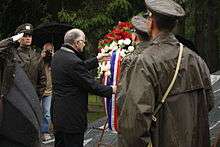
With the transition to democracy in the 1980s and 1990s, the interest in revealing information about the Bleiburg repatriations grew, and it continued to be abused for revisionist purposes in the Croatian mainstream.[153][154] In May 1994, an International Symposium for Investigation of the Bleiburg Tragedy was held in both Zagreb and Bleiburg, where several authors discussed the deaths at Bleiburg and estimated them to be in the tens of thousands. This was later published by Školska knjiga as Od Bleiburga do naših dana.[2]
The Republic of Croatia, by an act of the Croatian Parliament in 1995, started to officially commemorate the victims at Bleiburg,[155] at a time when Franjo Tuđman and the Croatian Democratic Union (HDZ) were in power.
More recently, as commemorative events became less of a political event, the radicals were largely marginalized and the focus of the commemoration turned to the actual victims of the repatriations.[154] Many top-ranking politicians and Catholic and Muslim clerics visit the Bleiburg site annually. Prime Minister Ivica Račan visited the site in 2002.[156] Prime Minister Ivo Sanader visited the site in 2004.[157]
For the 60th anniversary commemorations in 2005 a large crowd was in attendance, with speeches by Croatian parliamentary speaker Vladimir Šeks and head of the Muslim Community of Croatia, Mufti Ševko Omerbašić.[158] In 2007, a new altar was installed at the site and was inaugurated by Cardinal Josip Bozanić before some 10,000 people.[159][160]
In 2007, Slovenia's government announced plans to make the Tezno trench a memorial park and cemetery.[161] In 2008, the Croatian and Slovenian governments reached an agreement of cooperation on organizing military cemeteries, similar to earlier agreements which Slovenia reached with Italy and Germany.[162]
Croatia's Prime Minister, Zoran Milanović, visited Bleiburg in September 2008. He stated that all victims had the right to a fair trial, and that his motive was not political.[163]
In 2009, Croatian President Stjepan Mesić criticized the Parliament's representatives who did not react to people in the crowd displaying Ustaše iconography, which is ostensibly illegal in Croatia, at a state-sponsored event.[164]
In 2010, Croatian president Ivo Josipović said he would not attend the year's May Bleiburg commemoration as long as Ustaše iconography was present,[165] although he did make a separate visit to the Bleiburg memorial in June in addition to his visit to the Tezno memorial.[166]
In 2012, Croatia's parliament decided to revoke funding for the annual Bleiburg commemoration.[167] The reason given by Milanović was that the government would not fund what had become a politically partisan event concentrating on the NDH, rather than mourning the victims.[168] In 2012, the Croatian leadership laid wreaths only at the monument in Tezno.[169]
As Croatian academician Vjeran Pavlaković, an assistant professor in the Department of Cultural Studies at the University of Rijeka, writes in Deifying the Defeated Commemorating Bleiburg since 1990,
"The blurring of the past and the present is an integral part of the Bleiburg commemorations; not only do the participants dress in Ustasa uniforms, display Ustasa insignia and iconography, and sell paraphernalia associated with the NDH and its leaders, but there is an active discourse about the Croatian War of Independence accompanied by images of heroes (as well as individuals guilty of war crimes) from the conflict in the 1990s."
Pavlaković concludes that
"[T]he effectiveness of Bleiburg to act as a site of memory can be attributed to the fact that it represents both a traumatic past, as well as a moment of rupture, or historical discontinuity. Both of these factors give the commemorations at Bleiburg emotional weight and political significance, especially at a point when Croatia was going through another historical transition in the 1990s. It also meant that the Bleiburg myth was easily manipulated; the victims of the Bleiburg tragedy were actively invoked not only to distort the Ustasa past, but to justify the resurgence of extreme nationalist political options. The Bleiburg myth became one of many historical moments that symbolized Croatian martyrdom, due to the prevailing narrative of victimization by Greater Serbian aggression during the 1990s. The martyrium myth is one of the most common archetypes in the taxonomy of myths... The danger of presenting the victims of Bleiburg exclusively as martyrs for the Croatian state, however, is that the reality of the NDH regime and the crimes it committed are ignored in the new, revised narrative of World War Two.[170]
Historiography
Unlike many other operations of the Partisans, which have been described in detail, little has been written on operations in Slovenia near the Austrian border during the week of 7–15 May 1945.[5] Postwar Yugoslav literature ascribed all human losses in May and June 1945 as military casualties in the final operations of the war.[171] All opposing armies and political opponents were characterized by the Yugoslav historiography as traitors and collaborators.[172] The events at Bleiburg were known as "final encirclement battles", "final military operations", and the "grand finale in Carinthia".[173] Bleiburg repatriations and its aftermath were first discussed in emigrant literature by anti-communists that managed to leave the country. One of the first book dealing with the subject was La Tragedia de Bleiburg, published by Croatian emigrants in Buenos Aires in 1963.[128]
The Minister and the Massacres, a 1986 book by Nikolai Tolstoy,[50] further publicized the issue, but it made various dubious claims about the repatriations that were roundly criticized by various historians and authors,[174][175][176][177] although it brought attention, more generally, to the persistent distortion of the story,[176] and to the issue of historians trusting contemporary records and purported eyewitness.[178][179]
Croatian-American historian Jozo Tomasevich described the events: "The annihilation of most quisling troops captured at the end of the war – which is a fact – was an act of mass terror and brutal political surgery, similar to that practiced by the Ustašas and the Chetniks earlier in the war."[180] Regarding Partisan treatment of Ustaše prisoners, Tomasevich notes: "Considering the nature of the struggle among the various competing forces during the Second World War in Yugoslavia, atrocities against the Serbian population in the territory of the Independent State of Croatia and pro-Partisan or dissident Croats, the fact that the Ustaše adhered to the Nazis to the bitter end, and finally the fact that the Ustaša leadership wanted to put its troops at the disposal of the Western Allies for possible use against Yugoslav and other Communists, no mercy on the part of the Yugoslav Partisans toward these troops could have been expected."[181]
British political scientist David Bruce MacDonald criticized the exaggeration of the number of victims:[147] "Inflating the numbers of dead at Bleiburg had several layers of significance. Firstly, it gave the Croats their own massacre at the hands of Serbs and/or Communists, which allowed them to counter the Serbs' Jasenovac genocide with one of their own. Secondly, it allowed Croats to distance themselves from the Serbs and the Communist regime that had carried out the massacres. They could portray Croatia as an unwilling participant in the SFRY, more a prisoner than a constituent nation. Thirdly, by suffering such a massacre, the Croats underwent their own 'way of Cross', as dubbed by most Croatians."
Regarding Tito's responsibility for the actions of the Partisans at the end of the war, Croatian lawyer Dominik Vuletić wrote: "...it should be mentioned that at the time of the Bleiburg events and the death marches that followed, he was the Prime Minister (DFJ), Minister of Defence, General Secretary of the Communist Party and the Supreme Commander of all Yugoslav Armed Forces, so de facto and de iure he had control over all the forces and was the most responsible individual in the country. The Yugoslav forces that participated in the Bleiburg events acted according to Tito's instructions and were under his control. [...] So, there can be no doubt that Josip Broz Tito had full effective control over the units involved in the crimes."[25] On 13 May, Tito allegedly dispatched a handwritten telegram to the supreme headquarters of the Slovene Partisan Army that arrived on 14 May, prohibiting "in the sternest language" the execution of prisoners of war and commanding the transfer of possible suspects to a military court. The authenticity of this telegram is disputed as it was not published in any collection of documents of the Yugoslav Army and did not have Tito's signature. Historian Nikolai Tolstoy called it "a clear forgery".[182]
British historian Keith Lowe dealt with the end of the war in his book Savage Continent: Europe in the Aftermath of World War II, where he wrote: "For countless millions of people throughout the eastern half of the continent, therefore, the end of the war did not signal ‘liberation’ at all, it merely heralded a new era of state repression. The Nazi terror was over: the Communist terror was about to begin".[183]
In popular culture
The surrender at Bleiburg was the subject of a 1999 film, Četverored, based on the 1997 novel of the same name by Ivan Aralica. Croatian-Australian painter Charles Billich painted a series of works on the event.[184]
Memorial sites
See also
| Wikimedia Commons has media related to Bleiburg repatriations. |
Notes
- 1 2 Dizdar, 2005
- 1 2 McAdams, C. Michael (1999). "Yalta and The Bleiburg Tragedy". Archived from the original on 16 August 2013. Retrieved 24 March 2015.
- ↑ Grahek Ravančić, 2008
- 1 2 Vladimir Žerjavić, Yugoslavia, Manipulations with the Number of Second World War Victims, hic.hr; accessed 18 September 2015.
- 1 2 3 4 Tomasevich 2001, p. 765.
- ↑ Pavlowitch 2008, p. 8.
- ↑ Goldstein 1999, p. 130.
- ↑ Tomasevich 2001, pp. 46–47.
- ↑ Tanner 2001, p. 142.
- ↑ Tomasevich 2001, p. 53.
- ↑ Tomasevich 2001, p. 63.
- ↑ Hančič & Podberšič 2008, p. 44.
- ↑ Tomasevich 2001, p. 583.
- ↑ Rulitz 2015, p. 12.
- ↑ Tanner 2001, p. 157.
- ↑ Rulitz 2015, pp. 16–17.
- ↑ Rulitz 2015, pp. 9–10.
- ↑ Tomasevich 1975, p. 226.
- 1 2 Rulitz 2015, p. 17.
- ↑ Dizdar 2005, pp. 121-22.
- ↑ Tomasevich 2001, p. 228.
- 1 2 3 Tomasevich 2001, p. 752.
- 1 2 Rulitz 2015, p. 122.
- ↑ Mikola 2008, p. 163.
- 1 2 Vuletić 2007, p. 137.
- ↑ Tomasevich 2001, p. 425.
- ↑ Tomasevich 2001, p. 430.
- ↑ Rulitz 2015, p. 15.
- ↑ Dizdar 2005, p. 121.
- ↑ Thomas, 1995, p. 30
- ↑ Vuletić 2007, pp. 136, 140.
- ↑ Thomas, 1995, p. 32
- ↑ Jancar-Webster, 1989, p. 46
- ↑ Dizdar 2005, p. 125.
- ↑ Dizdar 2005, pp. 127-28.
- 1 2 3 4 5 Rulitz 2015, p. 21.
- 1 2 Vuletić 2007, p. 140.
- ↑ Tomasevich 2010, p. 864.
- ↑ Radelić 2016, pp. 9-10.
- ↑ Rulitz 2015, p. 22.
- 1 2 Rulitz 2015, p. 23.
- ↑ Dizdar 2005, p. 132.
- ↑ Dizdar 2005, p. 133.
- 1 2 3 Vuletić 2007, p. 141.
- ↑ Miladinović 1991, p. 1187.
- 1 2 Portmann 2004, p. 68.
- ↑ Pavlowitch 2008, p. 265.
- ↑ Grahek Ravančić 2009, p. 45.
- 1 2 Dizdar 2005, p. 134.
- 1 2 Tolstoy, 1986
- ↑ Tolstoy, Nikolai (2000). "The Bleiburg Massacres". Southeastern Europe, 1918–1995. Croatian Heritage Foundation & Croatian Information Centre. ISBN 953-6525-05-4.
- ↑ Tomasevich 2001, p. 755.
- ↑ Tomasevich 2001, pp. 754-55.
- 1 2 Dizdar 2005, pp. 134-35.
- ↑ Portmann 2004, p. 71.
- ↑ Rulitz 2015, pp. 25-26.
- ↑ Rulitz 2015, pp. 28-29.
- ↑ Rulitz 2015, pp. 31-33.
- ↑ Rulitz 2015, p. 34.
- ↑ Dizdar 2005, p. 136.
- 1 2 Grahek Ravančić, 2008, p. 547
- ↑ Dizdar 2005, pp. 135-36.
- ↑ Rulitz 2015, pp. 34-35.
- ↑ Grahek Ravančić 2009, pp. 85-86.
- 1 2 Dizdar 2005, p. 137.
- 1 2 3 Dizdar 2005, p. 143.
- 1 2 Ferenc 2008, p. 155.
- 1 2 3 Lowe 2012, p. 253.
- ↑ Rulitz 2015, p. 37.
- ↑ Rulitz 2015, p. 38.
- ↑ Grahek Ravančić (2008), p. 535
- 1 2 3 4 5 6 Tomasevich 2001, p. 758.
- ↑ Grahek Ravančić (2008), p. 544
- ↑ Grahek Ravančić (2008), p. 543
- ↑ Shaw, 1973, p. 101
- 1 2 Vuletić 2007, p. 135.
- 1 2 3 4 Grahek Ravančić, 2008, p. 545
- 1 2 Tomasevich 2001, p. 757.
- ↑ Tomasevich, 2001, pp. 763-64
- ↑ "Počelo suočavanje s negativnim naslijeđem antifašizma". Vjesnik (in Croatian). 12 February 2011.
- 1 2 Grahek Ravančić, 2008, p. 546
- ↑ Ramet, 2006, p. 159.
- ↑ Vuletić 2007, p. 136.
- ↑ Rulitz 2015, pp. 60-62.
- 1 2 Rulitz 2015, p. 62.
- ↑ Grahek Ravančić 2009, pp. 190-91.
- ↑ Grahek Ravančić 2009, p. 196.
- ↑ Franci Strle: Veliki Finale na Koroškem (2nd edition, 1977), p. 398
- ↑ Vuletić 2007, p. 144.
- ↑ Booker 1997, p. 245.
- ↑ Dizdar 2005, p. 151.
- ↑ Grahek Ravančić 2009, pp. 206-207.
- 1 2 3 Lowe 2012, p. 254.
- ↑ Grahek Ravančić 2009, p. 212.
- ↑ Dizdar 2005, pp. 147-148.
- ↑ Grahek Ravančić 2009, p. 215.
- ↑ Grahek Ravančić 2009, pp. 218-219.
- ↑ Grahek Ravančić 2009, p. 226.
- ↑ Grahek Ravančić 2009, pp. 230-234.
- ↑ Grahek Ravančić 2009, p. 234.
- ↑ Lowe 2012, p. 261.
- ↑ Grahek Ravančić 2009, pp. 258-259.
- 1 2 Dizdar 2005, p. 152.
- ↑ Grahek Ravančić 2009, pp. 265-268.
- ↑ Grahek Ravančić 2009, pp. 271-273.
- ↑ Radelić 2016, pp. 15-16.
- ↑ Dizdar 2005, p. 148.
- ↑ Hančič & Podberšič 2008, pp. 52-53.
- ↑ Mikola 2008, p. 148.
- ↑ Grahek Ravančić 2009, pp. 240-241.
- ↑ Corsellis & Ferrar 2005, p. 87.
- ↑ Lowe 2012, pp. 260-261.
- ↑ Dizdar 2005, pp. 162-163.
- ↑ Grahek Ravančić 2009, p. 256.
- ↑ Portmann 2004, pp. 55-56.
- ↑ Dizdar 2005, p. 181.
- ↑ Grahek Ravančić 2009, p. 298.
- ↑ Dizdar 2005, p. 183.
- ↑ Ferenc 2008, p. 157.
- ↑ Dežman 2008, p. 201.
- ↑ Hančič & Podberšič 2008, p. 55.
- ↑ Rulitz 2015, pp. 137-138.
- 1 2 Pavlaković 2010, p. 134.
- ↑ Rulitz 2015, p. 137.
- ↑ Rulitz 2015, p. 175.
- ↑ Goldstein, Slavko. "Nisu svi zločini uvijek isti ... pa tako nisu isti ni Bleiburg i Jasenovac". Jutarnji list (in Croatian). Retrieved 24 March 2015.
- ↑ Rulitz 2015, pp. 138-140.
- 1 2 Grahek Ravančić 2009, p. 13.
- ↑ Prcela & Živić 2001, pp. XXIV-XXV.
- ↑ Prcela & Živić 2001, pp. 91-92.
- ↑ Prcela & Živić 2001, pp. 104-105.
- 1 2 Ferenc 2008, pp. 157-158.
- ↑ "Macelj - gora zločina!". Večernji list (in Croatian). Retrieved 24 March 2015.
- ↑ Ferenc 2012, p. 568.
- ↑ "Stratišta: "U iskapanju Hude jame Hrvati nam moraju pomoći, tamo su oni ubijali svoje"". Slobodna Dalmacija (in Croatian). Retrieved 24 March 2015.
- ↑ "Još jedna masovna grobnica otkrivena uz hrvatsko-slovensku granicu: Koliko ih još ima?" (in Croatian). Index.hr. Retrieved 25 March 2015.
- ↑ Rulitz 2015, p. 109.
- ↑ Rulitz 2015, p. 112.
- ↑ Grahek Ravančić 2009, p. 23.
- ↑ C.W. Bracewell, John R. Lampe (2012). "History of Croatia, World War II". Encyclopædia Britannica Online. Encyclopædia Britannica Inc. Retrieved 24 March 2015.
- 1 2 Geiger 2013, p. 94.
- ↑ Grahek Ravančić 2009, p. 330.
- ↑ Mikola 2008, p. 145.
- ↑ European Public Hearing on "Crimes Committed by Totalitarian Regimes", 2008, Jerca Vodušek Starič: p. 36.
- ↑ "Mitja Ferenc: Sprave ne bo nadomestil domovinski spomenik sredi Ljubljane". Delo (in Slovenian). 6 November 2011. Retrieved 5 January 2014.
- ↑ Goldstein, Ivo (8 November 2008). "Raspad i slom NDH, Bleiburg i križni put". Jutarnji list. Archived from the original on 7 November 2012. Retrieved 28 May 2012.
- 1 2 MacDonald, 2003, pp. 170–71
- ↑ Ridley, 1994.
- ↑ "U 581 Grobnici je 100.000 žrtava". Jutarnji list (in Croatian). 1 October 2009. Archived from the original on 6 August 2012. Retrieved 6 July 2012.
- ↑ Glenny, 1999, p. 530
- ↑ Job, Cvijeto (2002). Yugoslavia's Ruin: The Bloody Lessons of Nationalism, a Patriot's Warning. Rowman & Littlefield. p. 28. ISBN 0-7425-1784-5. Retrieved 28 May 2012.
- ↑ Pilsel, Drago. "Antifašisti priznaju partizanske zločine". Novi list (in Croatian). Retrieved 7 February 2013.
- ↑ Butković, Davor (10 January 2009). "Kraj ustaške ikonografije". Jutarnji list (in Croatian). Archived from the original on 7 November 2012. Retrieved 29 May 2012.
- 1 2 Pauković, Davor (2012). "Povijest, malo sadašnjosti, pa opet povijest" (in Croatian). Zagreb: The Political Science Research Centre. Retrieved 24 March 2015.
- ↑ Vukušić, Božo (2005). Bleiburg Memento (in Croatian). Zagreb: Udruga Hrvatski Križni Put. ISBN 953-95007-0-2.
- ↑ Račan apologizes to those who suffered because of Bleiburg Archived 16 September 2003 at the Wayback Machine.
- ↑ "PREMIJER IVO SANADER POSJETIO GRADIŠĆE I BLEIBURŠKO POLJE". Archived from the original on 2 April 2015. Retrieved 17 March 2015.
- ↑ 60th anniversary of Bleiburg commemorated Archived 16 February 2008 at the Wayback Machine.
- ↑ Bozanić's mass at Bleiburg with record number of pilgrims, jutarnji.hr; accessed 24 March 2015.
- ↑ "Bozani: Komunizam je sustavno provodio zloine" (in Croatian). javno.com. Archived from the original on 21 April 2008. Retrieved 17 March 2015.
- ↑ "Mjesto ubijenih Hrvata iz Bleiburga kao memorijalni park". Klix.ba. Retrieved 17 March 2015.
- ↑ "Hrvatska i Slovenija se obavezale na dostojno obilježavanje masovnih grobnica". Slobodna Dalmacija (in Croatian). Retrieved 24 March 2015.
- ↑ "Milanović posjetio Bleiburg: Motiv odlaska nije bio trgovačke prirode". index.hr. Retrieved 17 March 2015.
- ↑ "Mesić: Od Bleiburga ste napravili ustaški dernek". Oslobođenje (in Croatian). HINA. 19 May 2009. Retrieved 31 May 2012.
- ↑ "Ivo Josipović: U Bleiburg neću ići dokle god se tamo pojavljuju ljudi u crnom". Jutarnji list (in Croatian). 12 January 2010. Retrieved 28 May 2012.
- ↑ "Josipović odao počast žrtvama na Bleiburgu" (in Croatian). RTL Televizija. 20 June 2010. Retrieved 28 May 2012.
- ↑ "Bleiburg commemoration no longer to be held under parliament's auspices". T-portal.hr. 17 April 2012. Archived from the original on 7 July 2012. Retrieved 28 May 2012.
- ↑ "Milanović: U Bleiburgu se komemorirala vojska NDH, a ne žrtve". Southeast European Times (in Croatian). 12 May 2012. Retrieved 28 May 2012.
- ↑ "Top Croatian officials commemorate Tezno victims". T-portal.hr. 15 May 2012. Archived from the original on 9 July 2012. Retrieved 28 May 2012.
- ↑ Deifying the Defeated Commemorating Bleiburg since 1990, cairn.info; accessed 11 March 2017.
- ↑ Rulitz 2015, p. 100.
- ↑ Portmann 2004, p. 46.
- ↑ Rulitz 2015, p. 167.
- ↑ Horne, Alistair (5 February 1990). "The unquiet graves of Yalta". National Review. 42: 27. ISSN 0028-0038.
- ↑ Pavlowitch, Stevan K. (January 1989). "The Minister and the Massacres review". The English Historical Review. 104 (410): 274–276. doi:10.1093/ehr/civ.ccccx.274.
- 1 2 Booker 1997, p. 85.
- ↑ Booker 1997, p. 188.
- ↑ Musgrove (Ed.) 2009, p. 70
- ↑ Rees, 2007.
- ↑ Portmann 2004, p. 70.
- ↑ Tomasevich (1969), pp. 113–14
- ↑ Grahek Ravančić 2009, pp. 139-143.
- ↑ Lowe 2012, p. 265.
- ↑ Darko Zubrinic. "Croatian art". croatianhistory.net. Retrieved 17 March 2015.
Bibliography
- Booker, Christopher (1997). A Looking-Glass Tragedy: The Controversy Over The Repatriations From Austria In 1945. London, UK: Gerald Duckworth & Co Ltd. ISBN 9780715627389.
- Corsellis, John; Ferrar, Marcus (2005). Slovenia 1945: memories of death and survival after World War II. ISBN 1-85043-840-4.
- Dizdar, Zdravko (December 2005). "Prilog istraživanju problema Bleiburga i križnih putova (u povodu 60. obljetnice)" [An addition to the research of the problem of Bleiburg and the Way of the Cross (dedicated to their 60th anniversary)]. The Review of Senj (in Croatian). Senj, Croatia: City Museum Senj - Senj Museum Society. 32 (1): 117&ndash, 193. ISSN 0582-673X.
- Ferenc, Mitja (2008). "Secret World War Two mass graves in Slovenia". In Jambrek, Peter. Crimes Committed by Totalitarian Regimes (PDF). Ljubljana: Slovenian Presidency of the Council of the European Union. ISBN 978-961-238-977-2.
- Ferenc, Mitja (2012). "Tezno – najveće prikriveno grobište u Sloveniji. O istraživanju grobišta u protutenkovskom rovu u Teznom (Maribor)" [Tezno – The Biggest Hidden Mass Burial Site in Slovenia. On the Research of the Hidden Burial Site in the Antitank Ditch in Tezno (Maribor)]. Journal of Contemporary History (in Croatian). Ljubljana: Oddelek za zgodovino Filozofske fakultete Univerze v Ljubljani. 44: 539–569.
- Geiger, Vladimir (2013). "Human losses of Croats in World War II and the immediate post-war period caused by the Chetniks (Yugoslav Army in the Fatherland) and the Partisans (People's Liberation Army and the partisan detachment of Yugoslavia/Yugoslav Army) and the Yugoslav Communist authoritities. Numerical indicators". Review of Croatian history. Croatian institute of history. 8 (1): 77–121.
- Glenny, Misha (1999). The Balkans: Nationalism, War and the Great Powers, 1804–1999. New York: Penguin Books. ISBN 0-670-85338-0.
- Grahek Ravančić, Martina (2009). Bleiburg i križni put 1945: historiografija, publicistika i memoarska literatura [Bleiburg and the Death Marches 1945. Historiography, journalism and memoirs] (in Croatian). Zagreb: Hrvatski institut za povijest. ISBN 9789536324798.
- Grahek Ravančić, Martina (January 2008). "Izručenja zarobljenika s bleiburškog polja i okolice u svibnju 1945" [The handing over of prisoners from Bleiburg field and its surroundings in May 1945]. Journal of Contemporary History (in Croatian). Zagreb, Croatia: Croatian Institute of History. 39 (3): 531&ndash, 550. ISSN 0590-9597. Retrieved 24 March 2015.
- Hančič, Damjan; Podberšič, Renato (2008). "Totalitarian regimes in Slovenia in the 20th century". In Jambrek, Peter. Crimes Committed by Totalitarian Regimes (PDF). Ljubljana: Slovenian Presidency of the Council of the European Union. ISBN 978-961-238-977-2.
- Jancar-Webster, B. (1989). Women & revolution in Yugoslavia, 1941–1945. Denver: Arden Press.
- Klemenčič, Matjaž; Žagar, Mitja (2004). The Former Yugoslavia's Diverse Peoples: A Reference Sourcebook. ABC-CLIO. ISBN 978-1-57607-294-3.
- Lowe, Keith (2012). Savage Continent - Europe in the Aftermath of World War II. New York: Macmillan. ISBN 9781250015044.
- MacDonald, David Bruce (2003). Balkan holocausts?: Serbian and Croatian victim-centered propaganda and the war in Yugoslavia. Manchester University Press. ISBN 978-0-7190-6467-8.
- Mikola, Milko (2008). "Concentration and labour camps in Slovenia". In Jambrek, Peter. Crimes Committed by Totalitarian Regimes (PDF). Ljubljana: Slovenian Presidency of the Council of the European Union. ISBN 978-961-238-977-2.
- Miladinović, Veljko (1991). Prva proleterska. Knj. 4 [1st Proletarian Brigade. Book 4]. Beograd: Vojnoizdavački zavod JNA "Vojno delo". OCLC 441105996.
- Musgrove, D., ed. (2009). BBC History Magazine, Falsified Yugoslav Handover to Tito. Bristol: BBC Worldwide Publications. ISBN 978-0-9562036-2-5.
- Pavlowitch, Stevan K. (2008). Hitler's New Disorder: The Second World War in Yugoslavia. New York: Columbia University Press. ISBN 978-1-85065-895-5.
- Pavlaković, Vjeran (2010). "Deifying the Defeated. Commemorating Bleiburg since 1990". L'Europe en Formation. Centre international de formation européenne. 3 (357): 125–147.
- Portmann, Michael (2004). "Communist Retaliation and Persecution on Yugoslav Territory During and After World War II (1943-1950)". Tokovi istorije. Institut za noviju istoriju Srbije (1–2): 45–74.
- Prcela, John Ivan; Živić, Dražen (2001). Hrvatski holokaust [Croatian Holocaust] (in Croatian). Zagreb: Hrvatsko društvo političkih zatvorenika. ISBN 9789539776020.
- Radelić, Zdenko (2016). "1945 in Croatia". Review of Croatian History. Hrvatski institut za povijest (1): 9–66.
- Ramet, Sabrina P. & Davorka Matić (2007). Democratic transition in Croatia: value transformation, education & media. Texas A&M University Press. ISBN 1-58544-587-8.
- Ramet, Sabrina P. (2006). The three Yugoslavias: State-building and Legitimation, 1918–2005. Indiana University Press. ISBN 0-253-34656-8.
- Rees, Laurence (2007). Their Darkest Hour: People Tested to the Extreme in WWII. London: Ebury Press. ISBN 978-0-09-191757-9.
- Ridley, Jasper S. (1994). Tito. Constable. ISBN 0-09-471260-3.
- Rulitz, Florian Thomas (2015). The Tragedy of Bleiburg and Viktring, 1945. Northern Illinois University Press. ISBN 9781609091774.
- Rulitz, Florian Thomas (2012). The massacres of Bleiburg – Denied, forgotten, hidden and misinterpreted crimes against humanity in the area of Austrian-Slovenian Carinthia in May 1945. in: Mateja Čoh Kladnik, Neža Strajnar: Totalitarizmi - vprašanja in izzivi, 3/Totalitarianism – questions and challenges, Represivne metode totalitarnih režimov/ Repressive methods of totalitarian regimes,. p. 39-59. ISBN 978-961-93300-2-9.
- Tanner, Marcus (2001). Croatia: A Nation Forged in War. New Haven: Yale University Press. ISBN 978-0-300-09125-0.
- Thomas, N., Mikulan, K. and Pavelic, D. (1995). Axis Forces in Yugoslavia 1941–45. London: Osprey. ISBN 1-85532-473-3.
- Tolstoy, Nikolai (1986). The Minister and the Massacres. Hutchinson. ISBN 978-0-09-164010-1.
- Tomasevich, Jozo (1975). War and Revolution in Yugoslavia, 1941–1945: The Chetniks. 1. San Francisco: Stanford University Press. ISBN 978-0-8047-0857-9.
- Tomasevich, Jozo (2001). War and Revolution in Yugoslavia, 1941–1945: Occupation and Collaboration. 2. San Francisco: Stanford University Press. ISBN 978-0-8047-3615-2.
- Vucinich, Wayne S.; Tomasevich, Jozo (1969). Contemporary Yugoslavia: twenty years of Socialist experiment. University of California Press.
- Vuletić, Dominik (December 2007). "Kaznenopravni i povijesni aspekti bleiburškog zločina". Lawyer (in Croatian). Zagreb, Croatia: Pravnik. 41 (85): 125&ndash, 150. ISSN 0352-342X.
Further reading
- Cohen, P.J., Riesman, D., Serbia's Secret War: Propaganda and the Deceit of History, Texas A&M University Press, 1996; ISBN 0-89096-760-1
- Epstein, Julius (1973). Operation Keelhaul: the story of forced repatriation from 1944 to the present. Devin-Adair Co. ISBN 978-0-8159-6407-0.
